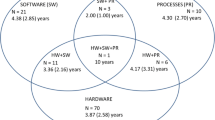Abstract
This paper deals with the limitations and chances of usability methods focused on quantitative data. It presents a usability field study of an anaesthesia device performed at a children’s hospital, emphasizing the advantages and limitations of the methods used. It reflects on the experience of conducting the study, moves on to lessons learned, and highlights possible improvements to the quality and cost-benefit relationship of this type of studies, in order to support the design of future products.
Résumé
L’article traite des limitations et possibilités des approches d’utilisabilité centrées sur des données quantitative. Il présente une étude d’un dispositif d’anesthésie réalisée dans un hôpital d’enfants, mettant en évidence les avantages et limitations des méthodes utilisées. Il reflète l’expérience gagnée au niveau de la conduite de l’étude, indique des leçons tirées et mets en évidence à quel niveau il serait possible d’améliorer la qualité et le rapport coût-bénéfice de ce type d’études afin de soutenir la conception des futurs produits.
Zusammenfassung
Dieser Artikel befasst sich mit den Grenzen und Chancen von Usability-Methoden, welche als Ergebnis quantitative Daten liefern. Dies wird beispielhaft anhand der Feldstudie eines Anästhesiegerätes erläutert, welches im laufenden Betrieb in einer Kinder-Tagesklinik untersucht wurde. Im Fokus dieser Untersuchung lag es die Vorteile und Grenzen unterschiedlicher Methoden aufzuzeigen, die als Ergebnis ausschließlich quantitative Daten liefern. Die Erfahrungen der durchgeführten Studie werden erläutert und Verbesserungspotentiale werden aufgezeigt, um die Qualität und das Kosten-Nutzen-Verhältnis dieser Art von Studie zu verbessern und um die zukünftige Produktgestaltung hierdurch nachhaltiger zu unterstützen.
Similar content being viewed by others
References
Backhaus C: Usability — Engineering in der Medizintechnik: Grundlagen — Methoden — Beispiele: Springer, 2009
Bangor, A.; Kortum, P.; Miller, J.:. An Empirical Evaluation of the System Usability Scale. International Journal of HumanComputer Interaction. 24 (6): 574–594, 2008
Bijker W.E.: Why and How Technology Matters. In: Goodin, R.E.; Tilly, C. (ed). The Oxford Handbook of Contextual Political Analysis. New York: Oxford University Press, 681–706, 2006
Brooke, J.: SUS — A quick and dirty usability scale. Available at: http://www.usabilitynet.org 1996
Garmer, K.; Liljegren, E.; Osvalder, A.L.; Dahlman, S.: Arguing for the need of triangulation and iteration when designing medical equipment. Journal of Clinical Monitoring and Computing 17 (2): 105–114, 2002
Hallbeck, M.S.; Koneczny, S.; Büchel, D.; Matern, U.: Ergonomic usability testing of operating room devices. Studies in Health Technology & Informatics, 132: 147–152, 2008
Hassenzahl, M.; Burmester, M. F.: Der User Experience (UX) auf der Spur: Zum Einsatz von www.attrakdiff.de. In: Brau, H., Diefenbach, S., Hassenzahl, M., Koller, F., Peissner, M. & Röse, K. (Hrsg.): Usability Professionals. Stuttgart: German Chapter der Usability Professionals Association, 78–82, 2008
ISO 9241-210: Ergonomics of human-system interaction — Part 210: Human-centred design for interactive systems. 2010
Jordan, P. W.: An Introduction to Usability. London: Taylor & Francis Ltd. 1998
Knoblauch, H.: Fokussierte Ethnographie. In: Sozialer Sinn, 1:123–141, 2001
Liljegren, E.; Osvalder A.L.: Cognitive engineering methods as usability evaluation tools for medical equipment. International Journal of Industrial Ergonomics 34, 49–62, 2004
Mol, A.: The Body Multiple. Ontology in Medical Practice. Durham and London: Duke University Press, 2002
Molich, R; Chattratichart, J; Hinkle, V; Jensen, J.J., Kirakowski, J.; Sauro, J.; Sharon, T; Traynor, B.: Rent a Car in Just 0, 60, 240 or 1,217 Seconds? In: Journal of Usability Studies 6, 8–24, 2010
Polson, P.G.; Lewis, C.; Rieman, J.; Whartin, C.: Cognitive Walkthroughs: A method for theory-based evaluation of user interfaces. International Journal of Man-Machine Studies, 36: 741–773, 1992
Röbig, S.; Didier, M.; Bruder, R.: Internationales Verständnis von Usability sowie Methodenanwendung im Bereich der Usability. 5. VDI Fachtagung USEWARE 2010 Grundlagen — Methoden — Technologien. Düsseldorf: VDI Verlag GmbH, 345–354, 2010
Röbig, S.; Didier, M.; Bruder, R.: Ergonomics and Usability in an International Context. In: Karwowski, W.; Stanton, N.; Soares, M. (Eds.): Handbook of Human Factors and Ergonomics in Consumer Product Design. Taylor & Francis: 213–225, 2011
Sawyer, D.: Do it by design. An Introduction to Human Factors in Medical Devices. U.S. Department of Health and Human Services. Springfield: FDA, 1997
Author information
Authors and Affiliations
Rights and permissions
About this article
Cite this article
Morales, K.L., Röbig, S. & Bruder, R. Learning from doing: Chances and constraints of studying medical devices through usability methods in field studies. Z. Arb. Wiss. 66, 115–128 (2012). https://doi.org/10.1007/BF03373868
Published:
Issue Date:
DOI: https://doi.org/10.1007/BF03373868
Schlüsselwörter
Mots clés
- Dispositifs médicaux
- dispositif d’anesthésie
- approches d’utilisabilité
- étude sur le terrain
- données quantitatives




